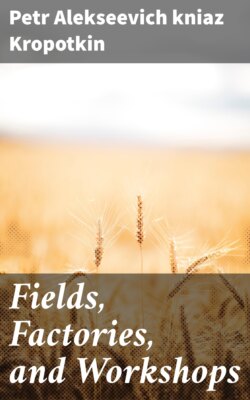Читать книгу Fields, Factories, and Workshops - Petr Alekseevich kniaz Kropotkin - Страница 7
На сайте Литреса книга снята с продажи.
Footnote
ОглавлениеTable of Contents
[1] See Appendix A.
[2] See Appendix B.
[3] For the last few years, since the Japanese war, the figures were uncertain. It appeared, however, in 1910, that there were in the empire, including the industries paying an excise duty, 19,983 establishments, employing 2,253,790 persons, and showing a yearly production of 4,565,400,000 roubles (£494,600,000). Out of them, the industrial establishments under the factory inspectors in European Russia proper, Poland, and the four northern provinces of Caucasia numbered 15,720, employing 1,951,955 workpeople, out of whom 1,227,360 were men, 521,236 women, and 203,359 children.
[4] The yearly imports of raw cotton from Central Asia and Transcaucasia represent, as a rule, about one-tenth part of the total imports of raw cotton (£1,086,000, as against £11,923,000 in 1910). They are quite a recent growth, the first plantations of the American cotton tree having been introduced in Turkestan by the Russians, as well as the first sorting and pressing establishments. The relative cheapness of the plain cottons in Russia, and the good qualities of the printed cottons, attracted the attention of the British Commissioner at the Nijni Novgorod Exhibition in 1897, and are spoken of at some length in his report.
[5] The yearly production of the 1,037 woollen mills of Russia and Poland (149,850 workpeople) was valued at about £25,000,000 in 1910, as against £12,000,000 in 1894.
[6] Report of Vice-Consul Green, The Economist, 9th June, 1894: “Reapers of a special type, sold at £15 to £17, are durable and go through more work than either the English or the American reapers.” In the year 1893, 20,000 reaping machines, 50,000 ploughs, and so on, were sold in that district only, representing a value of £822,000. Were it not for the simply prohibitive duties imposed upon foreign pig-iron (two and a half times its price in the London market), this industry would have taken a still greater development. But in order to protect the home iron industry—which consequently continued to cling to obsolete forms in the Urals—a duty of 61s. a ton of imported pig-iron was levied. The consequences of this policy for Russian agriculture, railways and State’s budget have been discussed in full in a work by A. A. Radzig, The Iron Industry of the World. St. Petersburg, 1896 (Russian).
[7] Out of the 1,500 steamers which ply on Russian rivers one-quarter are heated with naphtha, and one-half with wood; wood is also the chief fuel of the railways and ironworks in the Urals.
[8] The output was, in 1910, 24,146,000 tons in European Russia, and 1,065,000 tons in Siberia.
[9] See Appendix C.
[10] Here are the figures obtained by the official census of 1908. In all the cotton industry, only 220,563 men (including boys), 262,245 women, and 90,061 girls less than eighteen years old were employed. They produced 6,417,798,000 yards of unbleached gray, and 611,824,000 yards of bleached white and coloured cottons—that is, 160 yards per head of population—and 1,507,381,000 lb. of yarn, valued £96,000,000. We have thus 12,271 yards of cotton, and 2,631 lb. of yarn per person of workpeople employed. For woollens and worsted there were 112,438 men and boys, 111,492 women, and 34,087 girls under eighteen. The value (incomplete) of the woven goods was about £40,250,000, and that of the yarn about £21,000,000. These figures are most instructive, as they show how much man can produce with the present machinery. Unfortunately, the real productivity in a modern factory is not yet understood by the economists. Thus, we saw lately Russian economists very seriously maintaining that it was necessary to “proletarize” the peasants (about 100,000,000) in order to create a great industry. We see now that if one-fourth, or even one-fifth, part only of the yearly increase of the population took to industry (as it has done in Germany), Russian factories would soon produce such quantities of all sorts of manufactured goods, that they would be able to supply with them 400 or 500 million people, in addition to the population of the Russian Empire.
[11] Many facts in point have also been collected in a little book, Made in Germany, by E. E. Williams. Unhappily, the facts relative to the recent industrial development of Germany are so often used in a partisan spirit in order to promote protection that their real importance is often misunderstood.
[12] Francke, Die neueste Entwickelung der Textil-Industrie in Deutschland.
[13] Cf. Schulze Gäwernitz, Der Grossbetrieb, etc.—See Appendixes D, E, F.
[14] The imports of German woollen stuffs into this country have steadily grown from £607,444 in 1890 to £907,569 in 1894, and £1,822,514 in 1910. The British exports to Germany (of woollen stuffs and yarns) have also grown, but not in the same proportion. They were valued at £2,769,392 in 1890, £3,017,163 in 1894, and £4,638,000 in 1906-1910 (a five years’ average).
